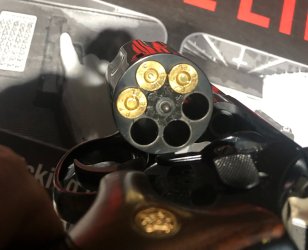jamesallen
Well-known member
- Joined
- Nov 24, 2018
- Messages
- 66
- Reaction score
- 35
I'm trying to figure out why my Model 19-9 is having a lot of trouble igniting cartridges lately. At least one or two rounds each cylinder fail to ignite the first time I fire them, but then they usually ignite the second time around. I'm using factory ammo that I got at the range, and I tried the same ammo in a couple of other revolvers and had almost no problems (only one failure to fire in 100 rounds). As per the advice on previous threads, I checked the mainspring screw and it was as tight as can be.
In addition, I am also finding that the cylinder gets stuck sometimes. I'll close it and it doesn't snap in, or even if it does snap in, it freezes and the trigger won't pull and the cylinder won't turn. This happens sporadically, and I am able to release it after working it open and shut a few times. And this has happened even with the area under the ejector star completely clean.
Should I send the gun to Smith and Wesson? Since neither of those two problems happens every single time, with the second one being particularly sporadic, I'm worried they'll say we can't duplicate either problem and can't find anything wrong.
In addition, I am also finding that the cylinder gets stuck sometimes. I'll close it and it doesn't snap in, or even if it does snap in, it freezes and the trigger won't pull and the cylinder won't turn. This happens sporadically, and I am able to release it after working it open and shut a few times. And this has happened even with the area under the ejector star completely clean.
Should I send the gun to Smith and Wesson? Since neither of those two problems happens every single time, with the second one being particularly sporadic, I'm worried they'll say we can't duplicate either problem and can't find anything wrong.

